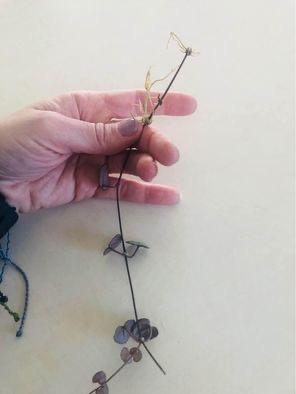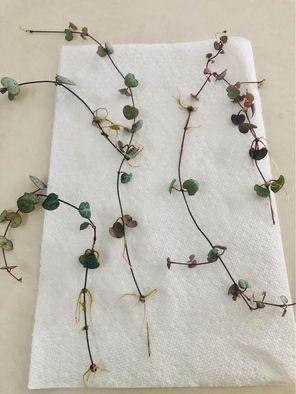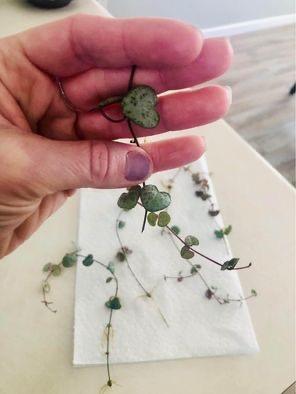
The string of heart plant (Ceropegia woodii) is an easy-to-care-for, unique, and attractive houseplant . It is a long-lived and fast-growing plant, and the sprawling vines can hang down several feet.

String of Hearts (Shadow Box)
The heart-shaped, fleshy, gray-green foliage has an eye-catching marbled pattern. They are generally propagated by stem cuttings rather than seed germination. Warm temperatures and good air circulation produce best results.
These plants don’t appreciate high humidity in winter dormancy phase .
My Experience
I love how they are heart shaped, it makes them a popular, highly sought after plant 🙂 I already had a healthy plant, and soooo….I wanted to see if I could propagate it! I’ve found as far as propagation goes, it’s easier to propagate in water.



With water propagation it’s as simple as that, but I put them in a smaller vase where it’s skinnier at the top and the string down at the bottom. This allows the air to get in and still has enough water. The fluted vase closes up a little bit at the top creating a greenhouse effect, making propagation easier.
| Botanical Name | Ceropegia woodii |
| Common Name | String of hearts, Rosary vine, Chain of hearts, Chinese lantern |
| Plant Type | Succulent, Vine, Evergreen |
| Mature Size | 2-5 cm. tall, 2 – 4 m. wide spread |
| Sun Exposure | Partial Sun |
| Soil Type | Well-drained, Fertile |
| Soil pH | Acidic, Neutral |
| Bloom Time | Summer, Fall |
| Flower Color | White to a pale purplish-red |
| Hardiness Zones | 9 – 12, USA |
| Native Area | Southern Africa |
Here are a few tips to help you take care of your String of Hearts plant:
- Lighting: The String of Hearts prefers bright, indirect light. You may want to place it near a window that gets plenty of sunlight but not in direct sunlight, as the plant can burn.
- Watering: Allow the soil to dry out between waterings. When you water, be sure to give it a thorough soaking until water runs out of the bottom of the pot. Overwatering can lead to root rot, so be cautious.
- Soil: The String of Hearts prefers well-draining soil. You may want to use a cactus or succulent mix that can provide the necessary drainage and aeration.
- Fertilizing: You can feed your String of Hearts plant with a balanced houseplant fertilizer once a month during the growing season, which is spring and summer months.
- Temperature and Humidity: The String of Hearts plant prefers warm temperatures and good air circulation. It doesn’t appreciate high humidity levels during its winter dormancy phase.
- Propagation: The String of Hearts plant can easily be propagated by stem cuttings. Simply take a cutting from a healthy vine and place it in soil or water. Wait for roots to grow and then plant it in soil.
What people like most about the string of hearts plant:
- The unique and attractive heart-shaped foliage, with its beautiful marbled pattern.
- The plant’s long-lived and fast-growing nature, allowing it to fill out hanging baskets or climb up trellises.
- Its easy-to-care-for nature, making it a great choice for beginners or those with busy schedules.
- This plant is generally propagated by stem cuttings, which is a simple and rewarding activity for gardeners.
- The string of hearts’ trailing vines can hang down several feet, creating a beautiful display in any home.
The String of Hearts plant is a delightful houseplant that is unique and easy to care for. With its attractive marbled foliage and sprawling vines that can grow several feet long, this plant is a great addition to any indoor garden. Propagated by stem cuttings and preferring warm temperatures and good air circulation, the String of Hearts requires little attention. However, be mindful of high humidity during its winter dormancy phase. With these simple care tips, your String of Hearts plant is sure to thrive and bring joy to your home for years to come.
0


